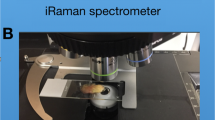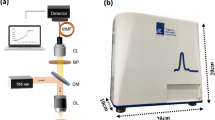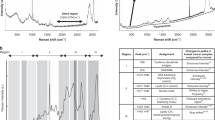Abstract
Raman spectroscopy can provide a rapid, label-free, nondestructive measurement of the chemical fingerprint of a sample and has shown potential for cancer screening and diagnosis. Here we report a protocol for Raman microspectroscopic analysis of different exfoliative cytology samples (cervical, oral and lung), covering sample preparation, spectral acquisition, preprocessing and data analysis. The protocol takes 2 h 20 min for sample preparation, measurement and data preprocessing and up to 8 h for a complete analysis. A key feature of the protocol is that it uses the same sample preparation procedure as commonly used in diagnostic cytology laboratories (i.e., liquid-based cytology on glass slides), ensuring compatibility with clinical workflows. Our protocol also covers methods to correct for the spectral contribution of glass and sample pretreatment methods to remove contaminants (such as blood and mucus) that can obscure spectral features in the exfoliated cells and lead to variability. The protocol establishes a standardized clinical routine allowing the collection of highly reproducible data for Raman spectral cytopathology for cancer diagnostic applications for cervical and lung cancer and for monitoring suspicious lesions for oral cancer.
This is a preview of subscription content, access via your institution
Access options
Access Nature and 54 other Nature Portfolio journals
Get Nature+, our best-value online-access subscription
$29.99 / 30 days
cancel any time
Subscribe to this journal
Receive 12 print issues and online access
$259.00 per year
only $21.58 per issue
Buy this article
- Purchase on Springer Link
- Instant access to full article PDF
Prices may be subject to local taxes which are calculated during checkout








Similar content being viewed by others
Data availability
Source data are provided with this paper.
References
O’Dowd, G., Bell, S. & Wright, S. Wheater’s Pathology: A Text, Atlas and Review of Histopathology 6th edn (Elsevier, 2020).
Koss, L. G. & Melamed, M. R. Koss’ Diagnostic Cytology and Its Histologic Bases (Lippincott Williams & Wilkins, 2005).
Raju, K. Evolution of Pap stain. Biomed. Res. Ther. 3, 490––500 (2016).
Koliopoulos, G. et al. Cytology versus HPV testing for cervical cancer screening in the general population. Cochrane Database Syst. Rev. 8, CD008587 (2017).
Diem, M. Introduction to Modern Vibrational Spectroscopy (Wiley, 1993).
Byrne, H. J., Sockalingum, G. D. & Stone, N. Raman microscopy: complement or competitor? in Biomedical Applications of Synchrotron Infrared Microspectroscopy: A Practical Approach (ed. Moss, D.) 105–143 (Royal Society of Chemistry, 2011).
Moss, D., ed. Biomedical Applications of Synchrotron Infrared Microspectroscopy (Royal Society of Chemistry, 2011).
Byrne, H. J. et al. Spectropathology for the next generation: quo vadis? Analyst 140, 2066–2073 (2015).
Baker, M. J. et al. Clinical applications of infrared and Raman spectroscopy: state of play and future challenges. Analyst 143, 1735–1757 (2018).
Wong, P. T. T., Wong, R. K., Caputo, T. A., Godwin, T. A. & Rigas, B. Infrared-spectroscopy of exfoliated human cervical cells—evidence of extensive structural-changes during carcinogenesis. Proc. Natl Acad. Sci. USA 88, 10988–10992 (1991).
Yazdi, H. M., Bertrand, M. A. & Wong, P. T. Detecting structural changes at the molecular level with Fourier transform infrared spectroscopy. A potential tool for prescreening preinvasive lesions of the cervix. Acta Cytol 40, 664–668 (1996).
Romeo, M. J., Quinn, M. A., Burden, F. R. & McNaughton, D. Influence of benign cellular changes in diagnosis of cervical cancer using IR microspectroscopy. Biopolymers 67, 362–366 (2002).
Walsh, M. J. et al. ATR microspectroscopy with multivariate analysis segregates grades of exfoliative cervical cytology. Biochem. Biophys. Res. Commun. 352, 213–219 (2007).
Schubert, J. M. et al. Spectral cytopathology of cervical samples: detecting cellular abnormalities in cytologically normal cells. Lab. Invest. 90, 1068–1077 (2010).
Kelly, J. G. et al. A spectral phenotype of oncogenic human papillomavirus-infected exfoliative cervical cytology distinguishes women based on age. Clin. Chim. Acta 11, 1027–1033 (2010).
Gajjar, K. et al. Histology verification demonstrates that biospectroscopy analysis of cervical cytology identifies underlying disease more accurately than conventional screening: removing the confounder of discordance. PLoS ONE 9, e82416 (2014).
Fung, M. F. K. et al. Comparison of Fourier-transform infrared spectroscopic screening of exfoliated cervical cells with standard Papanicolaou screening. Gynecol. Oncol. 66, 10–15 (1997).
Neviliappan, S., Fang Kan, L., Tiang Lee Walter, T., Arulkumaran, S. & Wong, P. T. T. Infrared spectral features of exfoliated cervical cells, cervical adenocarcinoma tissue, and an adenocarcinoma cell line (SiSo). Gynecol. Oncol. 85, 170–174 (2002).
Cohenford, M. A. et al. Infrared spectroscopy of normal and abnormal cervical smears: evaluation by principal component analysis. Gynecol. Oncol. 66, 59–65 (1997).
Cohenford, M. A. & Rigas, B. Cytologically normal cells from neoplastic cervical samples display extensive structural abnormalities on IR spectroscopy: implications for tumor biology. Proc. Natl Acad. Sci. USA 95, 15327–15332 (1998).
Chiriboga, L. et al. Infrared spectroscopy of human tissue. II. A comparative study of spectra of biopsies of cervical squamous epithelium and of exfoliated cervical cells. Biospectroscopy 4, 55–59 (1998).
Wood, B. R. et al. FTIR microspectroscopic study of cell types and potential confounding variables in screening for cervical malignancies. Biospectroscopy 4, 75–91 (1998).
Wong, P. T. T. et al. Detailed account of confounding factors in interpretation of FTIR spectra of exfoliated cervical cells. Biopolymers 67, 376–386 (2002).
Diem, M., Chiriboga, L., Lasch, P. & Pacifico, A. IR spectra and IR spectral maps of individual normal and cancerous cells. Biopolymers 67, 349–353 (2002).
Papamarkakis, K. et al. Cytopathology by optical methods: spectral cytopathology of the oral mucosa. Lab. Investig 90, 589–598 (2010).
Miljković, M., Bird, B., Lenau, K., Mazur, A. I. & Diem, M. Spectral cytopathology: new aspects of data collection, manipulation and confounding effects. Analyst 138, 3975–3982 (2013).
Diem, M. et al. Cancer screening via infrared spectral cytopathology (SCP): results for the upper respiratory and digestive tracts. Analyst 141, 416–428 (2016).
Lewis, P. D. et al. Evaluation of FTIR spectroscopy as a diagnostic tool for lung cancer using sputum. BMC Cancer 10, 640 (2010).
Townsend, D. et al. Infrared micro-spectroscopy for cyto-pathological classification of esophageal cells. Analyst 140, 2215–2223 (2015).
Old, O. et al. Automated cytological detection of Barrett’s neoplasia with infrared spectroscopy. J. Gastroenterol. 53, 227–235 (2018).
Pawley, J. B., ed. Handbook of Biological Confocal Microscopy revised edn. (Plenum Press, 1990).
Rubina, S., Amita, M., Kedar, K. D., Bharat, R. & Krishna, C. M. Raman spectroscopic study on classification of cervical cell specimens. Vib. Spectrosc. 68, 115–121 (2013).
Vargis, E., Tang, Y.-W., Khabele, D. & Mahadevan-Jansen, A. Near-infrared Raman microspectroscopy detects high-risk human papillomaviruses. Transl. Oncol. 5, 172–179 (2012).
Sahu, A. et al. Raman exfoliative cytology for oral precancer diagnosis. J. Biomed. Opt. 22, 1–12 (2017).
Sahu, A. et al. Raman exfoliative cytology for prognosis prediction in oral cancers: a proof of concept study. J. Biophotonics 12, e201800334 (2019).
Byrne, H. J. et al. Biomedical applications of vibrational spectroscopy: oral cancer diagnostics. Spectrochim. Acta A Mol. Biomol. Spectrosc 252, 119470 (2021).
Yosef, H. K. et al. Noninvasive diagnosis of high-grade urothelial carcinoma in urine by Raman spectral imaging. Anal. Chem. 89, 6893–6899 (2017).
Wehbe, K., Filik, J., Frogley, M. D. & Cinque, G. The effect of optical substrates on micro-FTIR analysis of single mammalian cells. Anal. Bioanal. Chem. 405, 1311–1324 (2013).
Bonnier, F. et al. Processing ThinPrep cervical cytological samples for Raman spectroscopic analysis. Anal. Methods 6, 7831–7841 (2014).
Behl, I. et al. Development of methodology for Raman microspectroscopic analysis of oral exfoliated cells. Anal. Methods 9, 937–948 (2017).
Duraipandian, S. et al. Raman spectroscopic detection of high-grade cervical cytology: using morphologically normal appearing cells. Sci. Rep. 8, 15048 (2018).
Traynor, D., Duraipandian, S., Martin, C. M., O’Leary, J. J. & Lyng, F. M. Improved removal of blood contamination from ThinPrep cervical cytology samples for Raman spectroscopic analysis. J. Biomed. Opt. 23, 1–8 (2018).
O’Dea, D. Raman Microspectroscopy for the Discrimination of Thyroid and Lung Cancer Subtypes for Application in Clinical Cytopathology. PhD thesis, Technological University Dublin (2020).
Ramos, I. et al. Raman spectroscopy for cytopathology of exfoliated cervical cells. Faraday Discuss 187, 187–198 (2015).
Kearney, P. et al. Raman spectral signatures of cervical exfoliated cells from liquid-based cytology samples. J. Biomed. Opt. 22, 1–10 (2017).
Traynor, D. et al. A study of hormonal effects in cervical smear samples using Raman spectroscopy. J. Biophotonics 11, e201700240 (2018).
Traynor, D. et al. The potential of biobanked liquid based cytology samples for cervical cancer screening using Raman spectroscopy. J. Biophotonics 12, e201800377 (2019).
Behl, I. et al. A pilot study for early detection of oral premalignant diseases using oral cytology and Raman micro‐spectroscopy: assessment of confounding factors. J. Biophotonics 13, e202000079 (2020).
Behl, I. et al. Raman microspectroscopic study for the detection of oral field cancerisation using brush biopsy samples. J. Biophotonics 13, e202000131 (2020).
Butler, H. J. et al. Using Raman spectroscopy to characterize biological materials. Nat. Protoc. 11, 664–687 (2016).
Morais, C. L. M., Lima, K. M. G., Singh, M. & Martin, F. L. Tutorial: multivariate classification for vibrational spectroscopy in biological samples. Nat. Protoc. 15, 2143–2162 (2020).
Ibrahim, O. et al. Improved protocols for pre-processing Raman spectra of formalin fixed paraffin preserved tissue sections. Anal. Methods 9, 4709–4717 (2017).
Kamemoto, L. E. et al. Near-infrared micro-Raman spectroscopy for in vitro detection of cervical cancer. Appl. Spectrosc. 64, 255–261 (2010).
Hologic. ThinPrep® 2000 Processor: Operator’s Manual, MAN-02585-001. https://www.hologic.com/sites/default/files/2018-05/MAN-02585-001_007_02.pdf (2017).
Kerr, L. T. & Hennelly, B. M. A multivariate statistical investigation of background subtraction algorithms for Raman spectra of cytology samples recorded on glass slides. Chemometr. Intell. Lab. Syst. 158, 61–68 (2016).
Behl, I. Raman Microspectroscopy for Detection of Oral Potentially Malignant Disorders Using Minimally Invasive Brush Biopsy Samples. PhD thesis, Technological University Dublin (2019).
Urvoy, M. & Autrusseau, F. Application of Grubbs’ test for outliers to the detection of watermarks. in IH&MMSec ’14: Proceedings of the 2nd ACM Workshop on Information Hiding and Multimedia Security 49–60 (ACM Press, 2014).
Hardin, J. & Rocke, D. M. The distribution of robust distances. J. Comput. Graph. Stat. 14, 928–946 (2005).
Hubert, M., Reynkens, T., Schmitt, E. & Verdonck, T. Sparse PCA for high-dimensional data with outliers. Technometrics 58, 424–434 (2016).
Afseth, N. K. & Kohler, A. Extended multiplicative signal correction in vibrational spectroscopy, a tutorial. Chemometr. Intell. Lab. Syst. 117, 92–99 (2012).
Brereton, R. G. & Lloyd, G. R. Partial least squares discriminant analysis: taking the magic away. J. Chemom. 28, 213–225 (2014).
Gautam, R., Vanga, S., Ariese, F. & Umapathy, S. Review of multidimensional data processing approaches for Raman and infrared spectroscopy. EPJ Tech. Instrum 2, 8 (2015).
Acknowledgements
This work was financially supported by Enterprise Ireland co-funded by the European Regional Development Fund (ERDF) and Ireland’s EU Structural Funds Programme 2007–2013, Health Research Board Collaborative Applied Research Grant CARG2012/29 to CERVIVA (www.cerviva.ie) and Science Foundation Ireland (12/IP/1494). I.B. and D.O’D. were supported by Dublin Institute of Technology Fiosraigh Postgraduate Scholarships.
Author information
Authors and Affiliations
Contributions
F.M.L. conceived the idea for the manuscript and co-wrote, compiled and finalized the manuscript. D.T., I.B. and D.O’D. co-wrote the manuscript and compiled the figures. H.J.B., F.B., A.M., F.O’C., S.N., A.M., S.F., S.G., C.M.H., C.M.M. and J.J.O’L. revised and edited the manuscript.
Corresponding author
Ethics declarations
Competing interests
The authors declare no competing interests.
Additional information
Peer review information Nature Protocols thanks the anonymous reviewers for their contribution to the peer review of this work.
Publisher’s note Springer Nature remains neutral with regard to jurisdictional claims in published maps and institutional affiliations.
Related links
Key papers using this protocol
Bonnier, F. et al. Anal. Methods 6, 7831–7841 (2014): https://doi.org/10.1039/C4AY01497A
Behl, I. et al. Anal. Methods 9, 937–948 (2017): https://doi.org/10.1039/C6AY03360A
Duraipandian, S. et al. Sci. Rep. 8, 15048 (2018): https://doi.org/10.1038/s41598-018-33417-8
Supplementary information
Source data
Source Data Fig. 3
Statistical source data.
Source Data Fig. 4
Statistical source data.
Source Data Fig. 5
Statistical source data.
Source Data Fig. 6
Statistical source data.
Source Data Fig. 7
Statistical source data.
Source Data Fig. 8
Statistical source data.
Rights and permissions
About this article
Cite this article
Traynor, D., Behl, I., O’Dea, D. et al. Raman spectral cytopathology for cancer diagnostic applications. Nat Protoc 16, 3716–3735 (2021). https://doi.org/10.1038/s41596-021-00559-5
Received:
Accepted:
Published:
Issue Date:
DOI: https://doi.org/10.1038/s41596-021-00559-5
This article is cited by
-
Learned end-to-end high-resolution lensless fiber imaging towards real-time cancer diagnosis
Scientific Reports (2022)
Comments
By submitting a comment you agree to abide by our Terms and Community Guidelines. If you find something abusive or that does not comply with our terms or guidelines please flag it as inappropriate.



